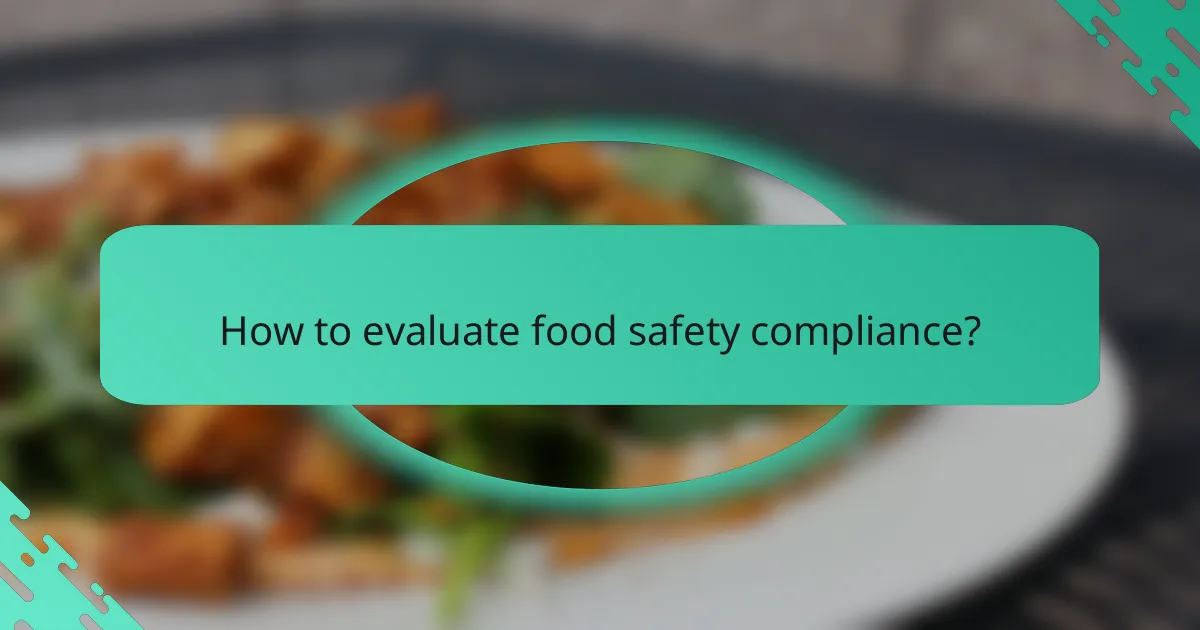Food safety practices are essential in the restaurant industry to protect public health and ensure compliance with local regulations. By implementing effective methods such as employee training, proper food storage, and routine inspections, establishments can significantly reduce the risk of foodborne illnesses. Evaluating compliance through audits and inspections further reinforces these safety measures, promoting a culture of accountability and excellence in food handling.

What are effective food safety practices in restaurants?
Effective food safety practices in restaurants include regular employee training, proper food storage techniques, routine kitchen inspections, the use of food thermometers, and cross-contamination prevention. Implementing these practices helps ensure food safety, compliance with health regulations, and the well-being of customers.
Regular employee training
Regular employee training is crucial for maintaining food safety standards in restaurants. Staff should be trained on hygiene practices, safe food handling, and the importance of following protocols to prevent foodborne illnesses.
Training sessions should occur at least annually, with refresher courses offered more frequently. Utilizing interactive methods, such as workshops or online courses, can enhance retention and engagement.
Proper food storage techniques
Proper food storage techniques are essential for preventing spoilage and contamination. Foods should be stored at appropriate temperatures, with perishable items kept below 5°C (41°F) and frozen items at -18°C (0°F) or lower.
Labeling food containers with expiration dates and using the FIFO (first in, first out) method can help ensure that older products are used first. Regularly checking storage areas for cleanliness and organization is also important.
Routine kitchen inspections
Routine kitchen inspections help identify potential hazards and ensure compliance with food safety regulations. Inspections should cover areas such as food storage, preparation surfaces, and equipment cleanliness.
Establishing a checklist for inspections can streamline the process and ensure that all critical areas are evaluated consistently. Addressing any issues promptly can prevent larger problems down the line.
Use of food thermometers
The use of food thermometers is vital for ensuring that food is cooked to safe temperatures. Different types of thermometers, such as digital instant-read or probe thermometers, can be used to check the internal temperature of meats and other dishes.
Cooking temperatures should meet or exceed recommended guidelines, such as 75°C (165°F) for poultry. Regular calibration of thermometers is necessary to maintain accuracy.
Cross-contamination prevention
Preventing cross-contamination is a key aspect of food safety in restaurants. This involves keeping raw and cooked foods separate, using different cutting boards for meats and vegetables, and regularly sanitizing surfaces and utensils.
Establishing designated areas for raw food preparation can help minimize risks. Staff should be trained to wash hands frequently and properly, especially after handling raw ingredients.

How to evaluate food safety compliance?
Evaluating food safety compliance involves systematic methods to ensure adherence to safety standards and regulations. Key evaluation methods include internal audits, third-party inspections, and the use of compliance checklists, each serving distinct purposes in maintaining food safety.
Internal audits
Internal audits are self-assessments conducted by a food establishment to evaluate its compliance with food safety standards. These audits typically involve reviewing processes, documentation, and practices to identify areas for improvement. Regular internal audits help maintain a proactive approach to food safety and can uncover potential issues before they escalate.
To conduct an effective internal audit, create a checklist based on relevant regulations and best practices. Schedule audits quarterly or biannually, and ensure all staff are trained on the audit process to foster a culture of safety.
Third-party inspections
Third-party inspections involve hiring external auditors to assess compliance with food safety regulations. These inspections provide an unbiased evaluation and can help identify gaps in safety practices that internal teams might overlook. They are often required for certification or to meet regulatory standards.
When selecting a third-party inspector, consider their credentials and experience in your specific industry. Inspections should be conducted at least annually, but more frequent assessments may be beneficial for high-risk food operations.
Compliance checklists
Compliance checklists are practical tools that outline the necessary steps and standards for maintaining food safety. These checklists can be tailored to specific operations and help ensure that all critical areas are covered during evaluations. They serve as a quick reference for staff to follow daily or weekly.
To create an effective compliance checklist, include key areas such as personal hygiene, equipment sanitation, and food storage practices. Regularly update the checklist to reflect any changes in regulations or operational procedures, ensuring it remains relevant and useful.

What are the local food safety regulations?
Local food safety regulations are guidelines established by authorities to ensure the safe preparation, handling, and storage of food. These regulations vary by location and are designed to protect public health by minimizing foodborne illnesses.
Food Code by the FDA
The Food Code is a model document developed by the FDA that provides a comprehensive set of guidelines for food safety practices in retail and food service establishments. While it is not mandatory, many states adopt it as a basis for their own regulations.
Key areas covered by the Food Code include food handling, employee hygiene, and equipment sanitation. Following these guidelines can help businesses comply with local laws and enhance food safety.
State-specific health department guidelines
Each state has its own health department that sets specific food safety regulations tailored to local needs. These guidelines often build upon the Food Code but may include additional requirements based on regional food safety concerns.
For example, some states may have stricter rules regarding temperature controls for food storage or specific training requirements for food handlers. Businesses should consult their state health department for the most current regulations.
Local food safety ordinances
Local governments may enact their own food safety ordinances that address specific community needs or risks. These ordinances can vary significantly even within the same state, reflecting local priorities and conditions.
Common elements in local ordinances include licensing requirements, inspection protocols, and penalties for non-compliance. It is crucial for food businesses to be aware of and adhere to these local laws to avoid fines and ensure public safety.

What are the best outcomes of food safety practices?
The best outcomes of food safety practices include a significant reduction in foodborne illnesses, increased customer trust, and an enhanced business reputation. These outcomes are crucial for maintaining a safe food environment and ensuring long-term success in the food industry.
Reduced foodborne illnesses
Implementing effective food safety practices leads to a notable decrease in foodborne illnesses. By adhering to proper hygiene, cooking temperatures, and storage guidelines, businesses can minimize the risk of contamination from pathogens such as Salmonella and E. coli.
Regular training for staff on food handling procedures and routine inspections can further bolster these efforts. For instance, ensuring that food is cooked to safe temperatures (typically above 75°C or 165°F) can significantly reduce the likelihood of illness outbreaks.
Increased customer trust
When food safety practices are prioritized, customer trust naturally increases. Consumers are more likely to return to establishments that demonstrate a commitment to safe food handling and preparation.
Transparency in food sourcing and preparation processes, such as displaying health inspection scores or certifications, can enhance this trust. Engaging with customers through educational initiatives about food safety can also foster a positive relationship.
Enhanced business reputation
A strong reputation for food safety can differentiate a business in a competitive market. Establishments known for their rigorous food safety standards often enjoy higher customer loyalty and positive word-of-mouth referrals.
Maintaining compliance with local health regulations and consistently achieving high ratings can further solidify a business’s standing. Regularly updating safety protocols and showcasing improvements can help sustain this enhanced reputation over time.

What criteria should be used for selecting food safety evaluation methods?
When selecting food safety evaluation methods, consider criteria such as cost-effectiveness, accuracy of results, and compliance with relevant regulations. These factors help ensure that the chosen methods provide reliable assessments while being economically viable for the organization.
Cost-effectiveness
Cost-effectiveness is crucial when evaluating food safety methods, as it directly impacts the overall budget of food safety programs. Organizations should assess both the initial investment and ongoing operational costs associated with each method. For example, rapid testing kits may have a higher upfront cost but can save money in labor and time over traditional methods.
To determine cost-effectiveness, consider the potential savings from reduced foodborne illness outbreaks and regulatory fines. A simple comparison of costs per test or per batch can provide insights into which methods offer the best value.
Accuracy of results
The accuracy of results is vital for effective food safety evaluations, as inaccurate results can lead to unsafe food products reaching consumers. Methods should be validated against established standards to ensure reliability. For instance, methods that provide results within low tens of minutes may be preferred if they maintain high accuracy levels.
When evaluating accuracy, consider the sensitivity and specificity of each method. High sensitivity minimizes false negatives, while high specificity reduces false positives. Organizations should also stay updated on advancements in testing technologies that can enhance accuracy.


